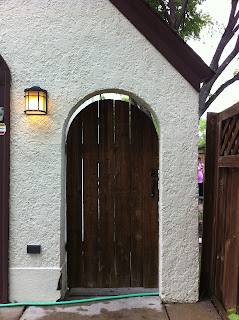--adventure by Tones--
The kids were napping upstairs, so I figured I could knock an easy item off the honey-do list while things were quiet on the home front. One of the outside lights on the 3-season porch hasn't worked since we moved in, so I figured I'd take a peek. This one shouldn't be too hard, right?
First thing's first: try a different bulb. Ha! If only life were that easy.
| No go on the new bulb. Still dead. |
The next step is to see if I'm getting voltage to the fixture. This is easy enough, as I have a handy-dandy voltmeter and I sorta know how to use it. Let's take the fixture off its mount so I can access the wiring. This is as easy as removing a couple thumb-screws... you know, AFTER I turn off the power at the switch!
There... let's pull out the wires and start measuring.
| HOLY CRAP!!! WASN'T EXPECTING THAT!! |
YIKES!! There's a wasp building a nest in the light fixture. Gotta take care of that before I stick my fingers in there! Luckily, the garaged is well stocked and I'm well armed.
While I'm at it, I hit a couple more locations around the house.
| There's a bugger above the speaker... |
| ...and one wayyyy up here on the garage. |
| Good use for this ladder... $65 at Menards. |
Three wasp nests? SUCCESS! SUCCESS!! SUCCESS!!! DIE! DIE!! DIE!!!
Now that we've killed all wasps within sight, it's time to get back to the task at hand: measuring voltage at the light fixture. This is as easy as (with the power OFF) pulling the wiring out of the fixture and hooking up the voltmeter leads. After I turn the power back on, I should be getting 120 volts, right?
| Exposed wiring should read 120v when energized. |
I'm getting 120 volts, so this means that the fixture itself is shot. This is actually good news, because installing a new fixture is easier than troubleshooting the wiring going into my porch! As luck would have it, I happened to have a light fixture that I never got around to installing at my old house (didn't have this blog back then). I'll install that fixture and maybe give the broken one to our pal at josh kadlac's blog to pull apart.
So, to make things even more interesting, the kids are up and eager to play outside. I have exposed wiring dangling above three puddles of wasp poison! No way can I let the kids out into that danger zone! I'm trying to concentrate at the task at hand, but the girls are now pounding on the windows and I've got to do something... so I pull out a patented move:
| This also works great for outside time-outs when the kiddos need one. |
I bought some cones to practice soccer and to play kick ball with the girls. Now they're doing a great job keeping them away from the dangerous voltage and poison throughout the yard. Safety: SUCCESS!!!
With the kiddos quarantined, I have time to throw the other light fixture up. The wiring is as simple as white wire to white wire and black wire to black wire. Of course, I did this with the POWER OFF!!
| Twist the wire nuts: black 2 black, white 2 white. |
Next step is to mount the lamp and flip the switch...
SUCCESS!!!!
Last step is to remove the quarantine and play with the kiddos! Good Dad: SUCCESS!!














































